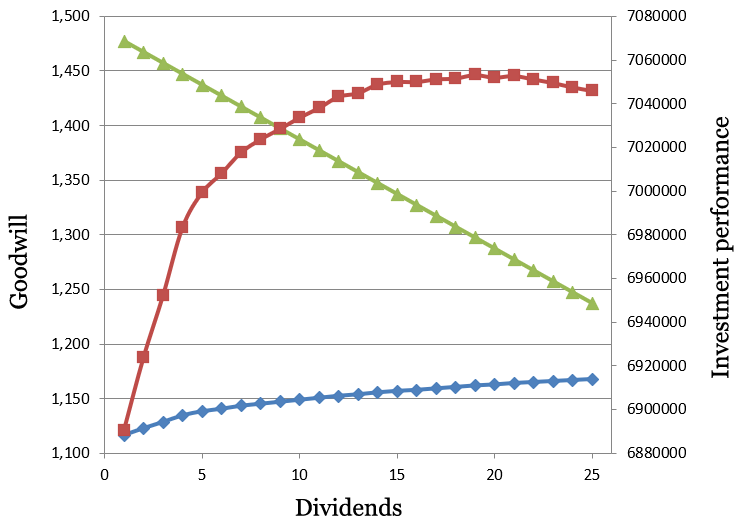Game mechanics - Dividends
06.02.2015
Normally, when anybody asked about dividend, the question sounds like - "How many dividends I need to pay in current period?". But this is an incorrect question, because it is important not only - how much to pay, but also - how to pay.
In old versions of GMC-simulator typical scheme of dividend payments was 2% + 8% (1% + 4% or 3% + 12%, distribution of payments 1 to 4). Pay 2% dividends in 3 period and 8% in 5 period (in old version of GMC-simulator dividends were payed through period). Then you need to calculate amount of dividends with preserving required liquidity of the company and split payment in 2 periods.
Schedule of dividends payment in new version of GMC-simulator playes much greater role than in previous, and therefore strategy of dividends payment is reduced to 2 key areas:
- Amount of dividends payment.
- Schedule of dividends payment.
Amount of dividends payment
Maximum possible amount of dividends depends on several limits:
- In 5 period it is necessary to maintain requied level of liquidity, because it is one of the goodwill factors. So, before the game you should prognoze how much profit you can get in each period and add this to cash balance. Requied level of liquidity in 5 period must be at least 10% of net assets of the company, the rest can be paid to shareholders as dividends.
- In previous paragraph you may decide that you need to pay the maximum amount of dividends based on 10% liquidity, but it is important to consider another limit. Remember how to calculate investment perfomance:
IP = MV + DIV + SIR, where MV = GW * NA
Payment of dividends increases IP through the term Dividends (DIV) in arithmetic progression. Also, due to the payment of dividends changes term MV, where on the one hand it increases Goodwill (GW), but on the ther hand decreases Net assets (NA). Finding right balance between all components will be the key to optimal amount for devidends payment.
Visually, this dependence can be seen on the chart. Horizontal - amount of dividends paid during the game. Vertical (left) - absolute value of goodwill factors. Vertical (right) - absolute value of investment perfomance. Blue - value of goodwill factor (dividends). Green - ratio between liquidity and net assets. Red - absolute value of the investment perfomance.

Chart shows that the optimum dividends payment will be in the area 18% - 20%, which must be properly distributed for 5 periods.
Schedule of payment of dividends
Important innovation in new version of GMC simulator was ability to pay dividends to shareholders every period, while in old version payment could be done only through the period. Finding optimal strategy for dividends payment thought testing is extremely difficult, because requires very large number of test groups with identical decisions. Searching relevant pairs for analysis in management reports database does not give desired result, but... good people helped, so read carefully.
Tests were made with different payment schedules with identical decisions. Test results show following rules of dividends payment:
- Payment schedule must be continuous. If you payed dividends in previous period, then be sure to pay dividends in current period. Therefore, if you are unsure that you have enough money for the following periods, it is better not to pay anything.
0% - 1% - 2% - 3% - 4% - Correct
1% - 0% - 2% - 3% - 4% - Incorrect - Payment of dividends should be started as early as possible. Ideally, payment has to be payed in 1 period, because each next period annual interest rate of the bank is added to the amount of payment, which takes into account of investment perfomance.
- Dividends payment in current period should be 50% more than payment in previous period, ie each subsequent payment should be increased by 1.5 times (rounded to the nearest whole number, in extreme cases payment may be equal to the previous one). Knowing total amount of dividends that should be payed during the game, you need to generate a shedule based on this coefficient.
| Total dividends | 1 period | 2 period | 3 period | 4 period | 5 period |
|---|---|---|---|---|---|
| 1 | 0 | 0 | 0 | 0 | 1 |
| 2 | 0 | 0 | 0 | 1 | 1 |
| 3 | 0 | 0 | 1 | 1 | 1 |
| 4 | 0 | 0 | 1 | 1 | 2 |
| 5 | 0 | 1 | 1 | 1 | 2 |
| 6 | 0 | 1 | 1 | 2 | 2 |
| 7 | 0 | 1 | 1 | 2 | 3 |
| 8 | 1 | 1 | 1 | 2 | 3 |
| 9 | 1 | 1 | 2 | 2 | 3 |
| 10 | 1 | 1 | 2 | 3 | 3 |
| 11 | 1 | 1 | 2 | 3 | 4 |
| 12 | 1 | 1 | 2 | 3 | 5 |
| 13 | 1 | 2 | 2 | 3 | 5 |
| 14 | 1 | 2 | 2 | 4 | 5 |
| 15 | 1 | 2 | 3 | 4 | 5 |
| 16 | 1 | 2 | 3 | 4 | 6 |
| 17 | 1 | 2 | 3 | 4 | 7 |
| 18 | 1 | 2 | 3 | 5 | 7 |
| 19 | 2 | 2 | 3 | 5 | 7 |
| 20 | 2 | 2 | 3 | 5 | 8 |
Optimal plan payment of dividends is built into the Calculation model, which can be purchased in our store.